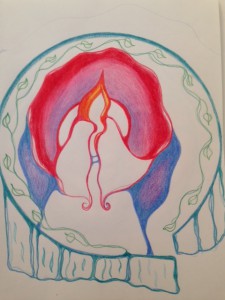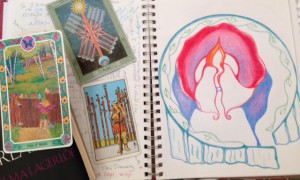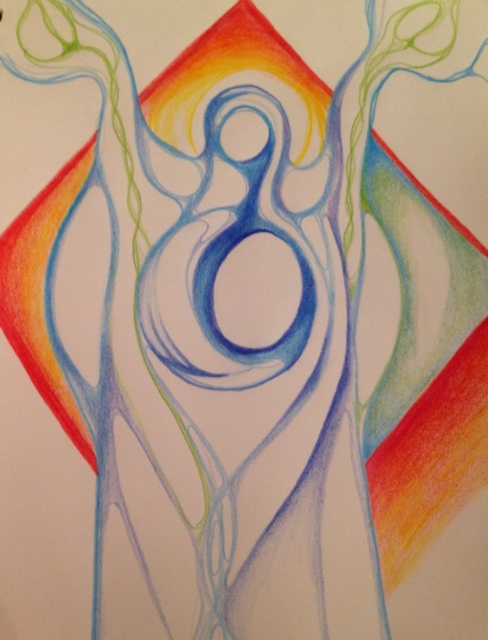 Living the Quest, I sit at the park with a friend in the sun watching our two nine year-olds inch incrementally down the blue plastic double slide. Five minutes later our boys have not progressed more than a quarter of the way down.
Living the Quest, I sit at the park with a friend in the sun watching our two nine year-olds inch incrementally down the blue plastic double slide. Five minutes later our boys have not progressed more than a quarter of the way down.
“What are you doing?” I ask my son.
“Taking the Slow Express,” he replies with glee, hands crossed over knees, knees against chest, gravity of body working against friction of shoe soles. The winner in this game is he who arrives last, just as on Quest there’s no “winning” or “arriving”…just the practice of questing with an open heart as we keep our goals in view.
This week’s Quest prompt asked us again to imagine looking back on the year and to take stock of what rhythmic activities we used in order to best engage with our Symphonic Activity for 2016. How did we care for body, mind, and spirit as we garnered new skills? How did we tend to work flow and creation each day to assure we got there?
With regular writing, meditating, and exercising rhythms in place, and a new working method to map out my blocks of time (I’m using a Mind Rooms Guide written by our fearless Quest leader, Jeffrey Davis), I consulted the Tarot cards to help me answer the last part of the prompt:
How do we allow our best selves to be quiet and still? To be primed for wonder?
The Nine of Wands as Key to Staying Primed for Wonder
I pulled the Tired Warrior, the Nine of Wands, (Rider Waite), which is depicted as Strength in the Thoth Deck. I recognize this grumpy warrior looking out on the horizon for the next battle. Having given that warrior a voice both in poetry and art for some time now, I consulted the Inner Child deck’s Nine of Wands. Here we see a fairy getting ready to open the gate to a new garden. I took her into meditation and drew what I saw waiting for me in the garden: circlet of a cape, resting on the ground, eager for a body to drape and warm.
At first the color of the cape was bull brown like that of The Little Lame Prince, by Dinah Maria Mulock (1874, England). Prince Dolor’s fairy godmother gives him the cape so he can sail out of the window of the tower of his imprisonment, skim the skies, and view the worlds below.
During my meditation, the cape slowly shifted from brown to red, like that of Little Red Riding Hood. Standing here at the threshold of midlife comes this beautiful call to re-enter the world of fairytales again despite wolf or threat of darkness ringing the wood and familiar cabin. What if we don’t just get to enter the garden once? What happens when you enter the fairytales again?
 This morning in the six a.m. mist as I walked the dog with my husband, I retold the story of the fairytale I’d read the night before, The Treasure (or Herr Arnes Hoard), by Selma Lagerlof (Lagerlof won the 1909 Nobel Prize in Literature), which is hailed as an “opposite fairytale” of the Prince Charming variety. Still wrapped in its woolly imagery of fishmongers, ships locked in frozen channels, and the red footprints of a missing sister, I spooked us both a bit and set us to circling the ghost tale in morbid fascination.
This morning in the six a.m. mist as I walked the dog with my husband, I retold the story of the fairytale I’d read the night before, The Treasure (or Herr Arnes Hoard), by Selma Lagerlof (Lagerlof won the 1909 Nobel Prize in Literature), which is hailed as an “opposite fairytale” of the Prince Charming variety. Still wrapped in its woolly imagery of fishmongers, ships locked in frozen channels, and the red footprints of a missing sister, I spooked us both a bit and set us to circling the ghost tale in morbid fascination.
Why would young Elsalille fall in love with a murderer? Why would the wealthy lover hide in plain sight? Why couldn’t she recognize him for who he was? By walk’s end we were quiet, scanning our private pasts.
I know I was, and thinking about how lovers one day become parents, delivering children into a landscape I hope we alter in some way with the light of our awareness for the better.
Related Links:
Sally Mitchell, Professor of English, Temple University, on The Little Lame Prince; Mitchell looks at possible reasons for why the tale resonates so deeply for women.
Lit2Go link to Chapter Summary of The Little Lame Prince
Selma Lagerlof: Surface and Depth by Jenny Watson, associate professor of German and Scandinavian Literature at University of Wisconsin-Milwaukee.
Nobel Prize page link to Selma Lagerlof’s biography
Photo Credit:
Butterfly, by Robyn Beattie, my poetry-movie collaborator

